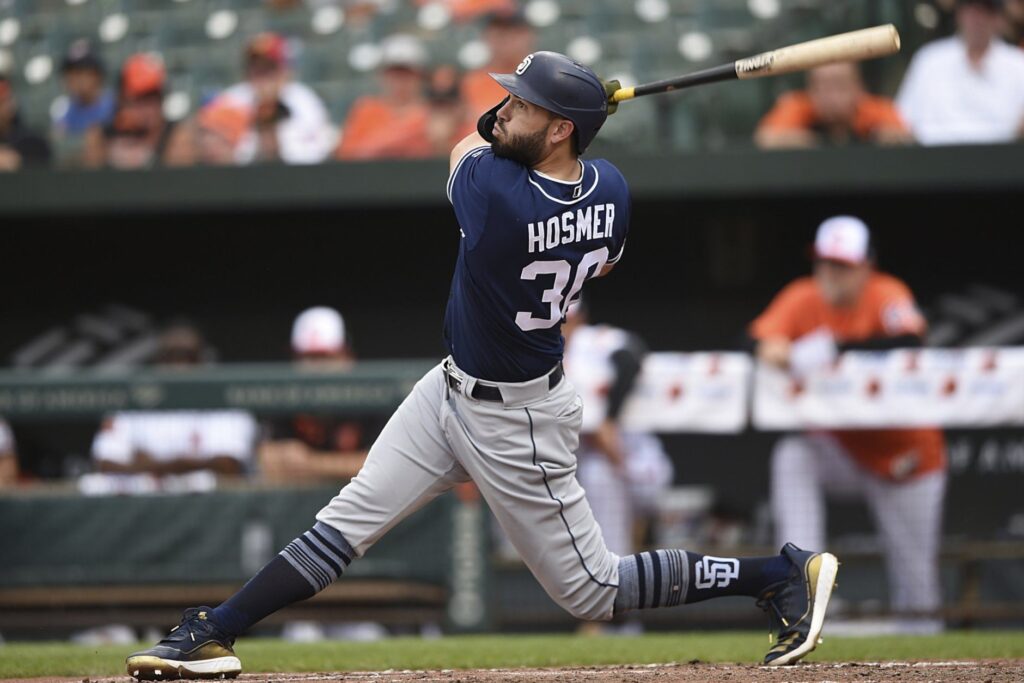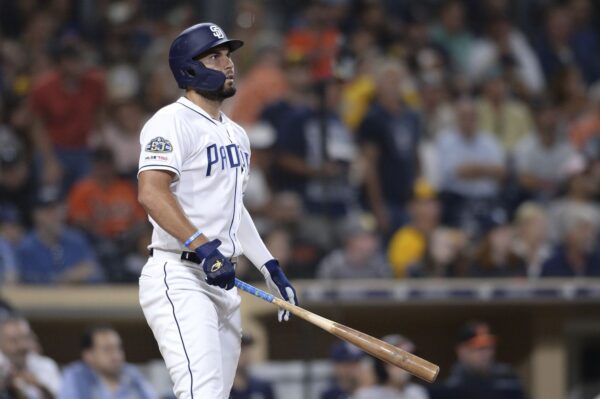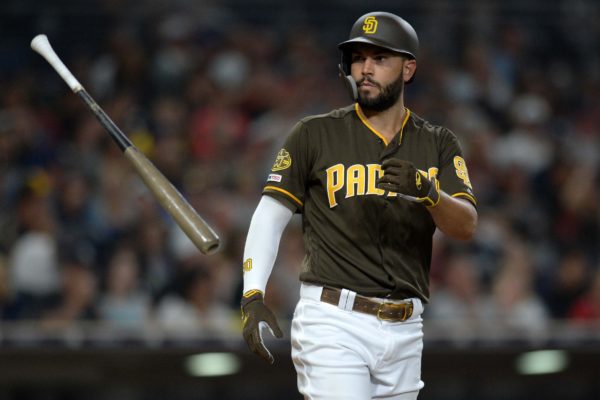Examining Eric Hosmer’s value at the plate

Credit: USA Today Sports

The San Diego Padres are heavily invested in Eric Hosmer. Can the first baseman provide some offensive firepower to a team that needs it?
When star first baseman Eric Hosmer signed with the San Diego Padres in February of 2018, the occasion promised to usher in a new era of baseball at Petco Park. Age 28 at the time, Hosmer already had a World Series ring, a quartet of Gold Gloves, as well as All-Star Game MVP and Silver Slugger awards under his belt.
An illustrious resumé, no doubt. And coming off of career highs in both batting average and home runs in the season before inking his eight-year, $144 million contract with San Diego, his representative, Scott Boras, was well warranted in lauding Hosmer’s “prestige value.”
His contract, then-the biggest in franchise history, signaled that the team was ready to commit to winning, both financially and philosophically.
Now, nearly two years later, the acquisition can be examined with the advantage of hindsight. Neither the Padres nor Hosmer have accomplished quite as much as they likely would have hoped to since then. Similar to the team as a whole, each of Hosmer’s last two seasons have come under scrutiny. Amidst a disappointing second half for the organization last year, social media has been rife with questions regarding his performance.
Whether or not those questions are justified remains to be seen, as neither the full extent of Hosmer’s contract nor the Padres’ window of contention have elapsed yet. But as the two-year anniversary of one of the biggest signings in Padres history (at least financially) approaches, the time may be right to take an objective look back at his first two seasons in a San Diego uniform, as well as to peer forward into Hosmer’s upcoming season.
During the lengthy free agent courtship of Hosmer in 2018, part of his allure was his presence at the plate. In the seven seasons he spent in Kansas City prior to his arrival in San Diego, the first baseman posted a .284 batting average, .342 on-base percentage, and .439 slugging percentage, with an average of 20 home runs and 88 RBIs each year.
He has yet to top many of those marks in a Padres uniform so far. His first two seasons in San Diego have seen him put up a .259/.316/.412 slash line with an average of 20 home runs and 84 RBIs.
The most significant decline is obviously in batting average. But that may not tell the whole story. His 20-plus point reduction in his time with San Diego so far versus the beginning of his career with Kansas City is undoubtedly disappointing. Still, his uncharacteristic .259 batting average in 2018 — his first season with the Padres — could be attributed to an abnormal offseason as he navigated free agency. Add in a switch from the American League to the National League, as well as being tasked with leading an anemic San Diego offense that year, and you have a host of circumstances that clearly took a toll on his performance.
Does this excuse a precipitous decline in performance in the first year of a multi-million-dollar contract? No. But those factors, paired with a slight upswing in Hosmer’s performance the following year should give a reason for optimism, however slight that reason may be, that Hosmer can return to his previous heights with the Royals.
His aforementioned 2019 season saw him take a step forward, but perhaps not big enough of a step. In his second year in a Padres uniform, he raised his batting average 12 points to a robust .265 and hit four more home runs than he did the season before (22).
Most notably, and most encouragingly, however, Hosmer added an impressive 30 RBIs to his total from the previous year, going from 69 to 99. He was able to do so by taking advantage of an invigorated Padres lineup that now features Manny Machado and Fernando Tatis Jr., posting a stellar .328 batting average with runners in scoring position. This mark was second to only Tatis Jr. and Josh Naylor, the latter of whom did so in only 57 plate appearances to Hosmer’s 148.

And it’s in this regard that Hosmer’s value at the plate from last season seems most clear — run production. He was second in total runs scored on the team to only Machado, responsible for 72 of the 682 total runs the Padres tallied that year. He was tied with Tatis Jr. for first on the team in at-bat/RBI ratio, averaging only 6.3 at-bats in between RBIs. Hosmer led all Padres with at least 300 plate appearances in productive out percentage, advancing or scoring runners 33.6 percent of the time. And he led the team by a landslide in terms of total baserunners he scored, besting Manny Machado by more than 22 runs with 81 base runners scored while he was at the plate.
There’s no way around Hosmer’s slide in overall offensive performance since he signed with San Diego, and to question if he has been worth his steep paycheck so far is valid. Hosmer is expensive, and players as expensive as him are likely expected to bat higher than .265, for example. Though he’s been a solid, dependable player for them, the Padres will undoubtedly need more out of Hosmer as they make a playoff and eventual World Series push this upcoming year and in following seasons.
But there also may be more to his value than initially meets the eye. With more Padres figuring to be circling the bases this season as part of an upgraded lineup, Hosmer’s ability to get runs scored at the very least should bring value to San Diego. Whether or not that value is commensurate with his hefty salary is certainly up for discussion, as the value of any player of his stature would be. Depending on who you ask, another campaign of improvement for Hosmer would be a step toward Padres finally reaping the full potential of the “prestige value” they desired when they inked him to his historic contract.
Padres fans, perhaps more than any other group of people, however, know that without real results, projections, hypotheticals, potential, and “prestige value” mean just about nothing. Hosmer, as well as several other Padres, will be looking to have transformative seasons in 2020.
Anderson Haigler is a freelance sports journalist from Escondido, California. This year is his third contributing to the East Village Times. Anderson recently graduated from the University of San Diego with a degree in Communication Studies, where he won three awards from the CCMA for both his sports and breaking news coverage for The USD Vista.
You could have just put “nonexistent” and saved yourself the trouble.
“Biggest decline is obviously BA”?
.25 lower in BA
.26 in OBP (Walks are not close to what they were)
.27 in slugging.
ROBUST .265? For a $20M+ NL DH (Horrific defense)?
“He’s a run producer” – His spot in the lineup, and the lineup are what primarily dictate RBIs. RISP is a fluky stat that doesn’t stick year to year, according to like 1000 analysts.
No mention of his negative WAR for the $40M he’s been paid so far? his 600 OPS vs LHP? That his brother is his swing coach and is against analytics and changing to be better?
I liked the writing style, but the substance seems to be missing quite a bit. Tommy T hit it on the head on this one.
Presumably we’re all Padres fans on this site, so skip the homer bias. If we wanted that there’s always MLB.com.
This article reads almost as a PR release. Do you work for the Padres? Or hope to do so when you graduate? Save your job application for some other method. Give us objective analysis, not this drivel.
If you go to Fangraphs, for instance, you’ll see that Hosmer is awful by almost any metric. A much better article would have explored ways the club might still get more value out of the player.
Preller is on his way out .pods will maybe ,be a 500 team
To many ifs.
I dont think the padres know what there doing .think rizzo,gonzalez,myers hosmer.what is the thought process.either build a team and stick with the best or get a bunch of scrubs.thats what preller is doing now.picking up lost dollars.keep what you have or trade the best to get the best.nick stenzel,why cant we get him,answer preller want to give them the junk pile.why not let Cordero get a real shot.and franzese at second.switch myers back to catcher.he will outhit hedges.or put the young catcher at second.has franzese caught since high school where he caught.
????????
Rooting for Hoz! RBIs win games. If Hoz hits .270 with 100 RBIs it will be great! But my disappointment last year were the errors. 14 errors by a 1st basemen is not going to help us win. Also a first basemen’s job is to help the other infielders by “saving “ potential errors. The Pads need Hoz to have a better year on the bag. Go Pads!
“His contract, then-the biggest in franchise history, signaled that the team was ready to commit to winning, both financially and philosophically.”
I get what you are saying, and why you wrote that, but the opposite is true. Why? While this revealed motivation to win (shouldn’t that be obvious for all teams?), more importantly, it revealed massive incompetence, both at the time, and now (e.g. no one else was trying to sign him; all the signs–which all other teams saw–pointed to decline, and declining to signing him; who falls for “prestige value”?)
“His aforementioned 2019 season saw him take a step forward…”
Again, the opposite is true. Look at the stats that truly determine a player’s value (in today’s stats), like WAR, etc…not RBI’s. By all these he declined even further, as was the least valued first basemen (or close to it). So, again, this is a misleading and false statement.
“Though he’s been a solid, dependable player for them…”
Again, the opposite is true.
The bottom line is Hosmer is horrible when compared to other first basemen. He is almost the worst, if not THE worst first basemen in the majors (statistically, on both offense and defense). There are multiple players on the roster who are, “objectively” speaking, significantly better than Hosmer, but they will not play over him. Why? Because Preller can’t/won’t admit to the worst signing in the past 10 to 30 years.
Agreed. Glad someone else made these points.